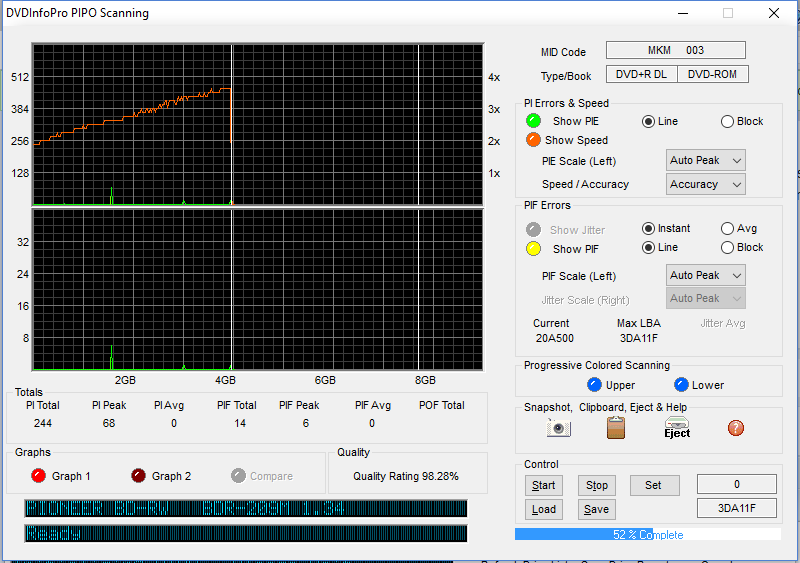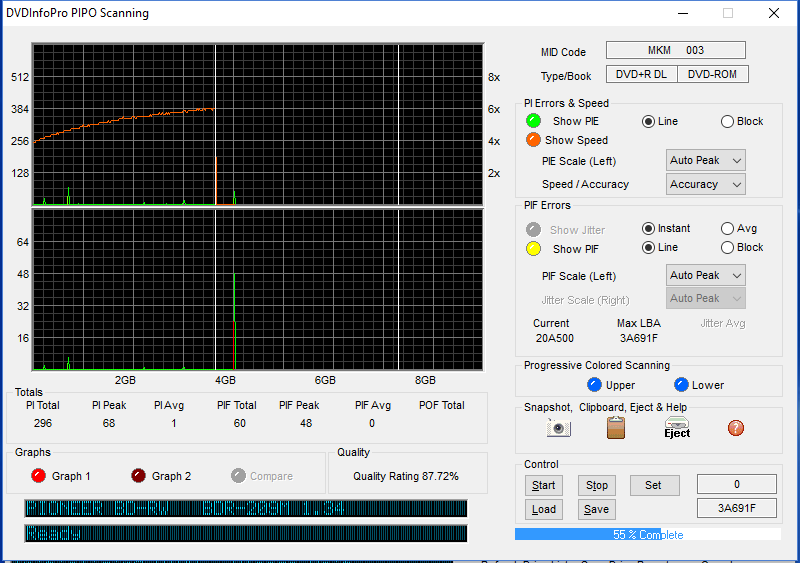-
Posts
8,648 -
Joined
-
Last visited
Content Type
Profiles
Forums
Events
Everything posted by dbminter
-
Yeah, 46.87 percent quality this time on the 2nd disc which had a 98 before the first time. These tests are unreliable, so screw them.
-
Now HOW can this be?! I started the test again on the 1st DVD+R DL and got a RADICALLY different result! It's not done yet, but at 53%, the PI total is now 75526, nearly 40,000 times the first test! Quality rating of 1%, where it was 87 before! So, what the Hell am I supposed to believe? Test one or test two? I've stopped this test and started it again. If I get the same standard deviation of 40,000, I say screw these tests. People put TOO much concern into them. As long as I'm using quality media, which I am, as long as the discs play, as long as the Verify against the source image in a different drive didn't return any issues, I saw screw it! How can I trust these tests when there's no consistency between them? And they may never even complete on the 2nd layer!
-
I think I'll try letting this 2nd DVD+R DL go overnight. I don't know how long these scans are supposed to take, but if it's not complete after 15 to 20 hours, it probably WON'T get done. Simple as that.
-
SOMETHING is wrong SOMEWHERE, it seems. Either the LG is not burning quality discs or the Pioneer is not reading them right in the PIPO tests. Everything goes rapidly until the 2nd layer, it seems, because at 50%, the test rate slows to the point where it probably can NEVER complete. It's been at 52% for the past 10 minutes. Since it's not even DONE a full percent in 10 minutes, it will take probably at least 480 minutes for this scan to complete! And it probably most likely never will complete. Attached is the results for the 2nd DVD+R DL that I stopped at somewhere between 52% and 53%, as it never made it to 53%.
-
I've decided to run a scan on the 2nd DVD+R DL disc I burned right after this first one I tried testing. See how that goes. If it goes at a speed where it will actually COMPLETE I'll see what the results of that are. That 2nd disc had no returned errors in the burn and verify log. If they seem to be good, I think, to be on the safe side, I'll try a 2nd burn of this first disc.
-
I can, of course, predict the future in most cases, just as I did with the ASUS drive. So, there's nothing I can do. The Pioneer scan will probably never complete and will just wear out the drive in the attempt.
-
Ah, and of damn well course, the LG drive isn't supported! Well, there's nothing else I can do but try the ASUS USB drive, which probably won't be supported, either.
-
I cancelled the scan in the Pioneer and will reattempt it in the LG. Here's the results that came through, though, from the scan I stopped.
-
I think something is wrong with this scan in the Pioneer. The drive was making a sound while the scan was running. It then stopped making noise. The drive light is still solid, but there's no sound coming from the drive. It's also been stuck at 55% for the past half hour. Even if the scan IS still running, it will take forever for it complete at this rate.
-
I'm running a PI/PIF scan in DVDInfo now. Now, I don't do these, well, hardly ever. I can't remember the last time I did one. And I don't know if it was on a DVD+R DL. It's been running for about an hour and a half is only 54% done. It seemed to complete 50% in the first half hour and is now still running. How long should such a test take on a DVD+R DL? It's only like 6 GB full, I think. Is this an indication it's finding a lot of problems because of how long it's taking? Or is it simply that these tests take a long time to run?
-
Now that I know it is called SECAM, I looked it up. SECAM was a television system type developed in 1956. It was primarily used by France and the Soviet Union for its TV standard. So, it was developed before VHS became widely available. It was a television standard. It's in the process of being phased out and replaced by DVB, the new European standard for digital TV's.
-
When building a DVD Video image, how does ImgBurn determine the TV System, PAL or NTSC? And does it just detect those 2 types? Isn't there at least one other one, called something like SECAM?
-
I had the same situation where I never got a warning from AnyDVD about the ISO creation. Because it never COULD warn me. I, too, was using AnyDVD as the decrypting layer and using ImgBurn's read mode to read the disc to image files. I did that because I have splitting set up with my images in case I need to split a DVD-9 image temporarily over 2 DVD-5's. I could have used AnyDVD's ISO read to a single file and ImgBurn's Build mode to create split images. Then, copying those split image files to a new image. Had I tried to use AnyDVD's ISO read mode, it probably would have warned me about the read mode of structurally protected discs. I only learned the hard way when I later tried to burn the read images and discovered that it only worked for some discs if Rip to HD was used instead of reading protected discs to images. It was after my first 2 discs I came across this "limitation" that I learned to always use Rip files to HD.
-
Yeah, what probably was the case is one VIDEO_TS fit on a single layer DVD while another VIDEO_TS would only fit on a dual layer DVD. You won't get the 2nd screen asking for a layer break position on DVD Video content that fits on a single layer DVD.
-
I could do that, but in this case I don't think it would point out any problem with the actual disc quality. The files Verify and play fine so it would probably pass a hash comparison as the files are not corrupted. What might be a problem down the road with PIPO or any other type of jitter may be that the disc fails to read at all sooner than it should.
-
Should I be worried about this being more than a fluke? I burned another MKM DVD+R DL immediately after the one in question and got no notices at all from the LG. I did a Verify against the image, and have played the entire movie from beginning to end on a PS3. The only thing not tested yet is the rest of the 2nd audio stream I'm playing and then the last audio stream of the disc. IF I can remember I'll see about getting a PIPO scan for you. You'll have to interpret it for me as I STILL can't read the damn things!
-
Got this at the layer change on a Verify of a burn in my LG BD burner. W 12:17:21 Failed to Read Sectors 1914032 - 1914063 - Reason: L-EC Uncorrectable Error However, the Verify continued on without a problem. So, is it possible for "uncorrectable" errors to correct themselves? It seems nothing was wrong as I ran a Verify against the image file in a different drive and there was nothing that indicated anything wrong on the Pioneer. And I played the entire contents, without a problem at the layer change. So, it seems everything was all right. But, if "uncorrectable" errors can correct themselves, why are they called uncorrectable errors? Is it because a retry was done and the retry itself didn't fail? Because there were no repeated failures of retries to the point where ImgBurn gives up, it's not considered an "error?"
-
Well, trying to play the disc that is causing problems on another PC would better nail down if the problem is the drive installed in your current PC or not.
-
Hm, it is unusual you don't have a problem playing this disc on your stand alone player, but you do on your PC drive. Since your files play fine from the hard drive and the disc plays in a stand alone apparently fine, the problem must be in your PC drive.
-
Plus, IMO, structurally protected DVD's might cause more actual physical wear and tear on your standalone DVD players. Protected discs take longer to load because the player has to skip over all those protected sectors crap. This means it takes longer to read the disc. More time is spent spinning up the motor, wearing it out sooner, if you ask me. I know on the PS3, it takes longer to start playing a protected DVD than it does to start just a CSS protected one. At least, with DVD's dying, the only company that seems to insist on protecting its DVD's anymore is Lionsgate. And no one is wanting to copy their crappy movies, anyway. So, they're just wasting their money protecting discs no one wants, let alone anyone wants to copy. More power to them if they want to accelerate profit loss by licensing a protection that won't stop anyone.
-
I can verify from experience it can happen. I tried to copy a DVD of a protected disc in my collection to ISO with AnyDVD. I didn't know back then about the different results you get between the ISO ripper and the HD ripper. I burned that ISO to a DVD+R DL, but it wouldn't play properly on my PS3. I tried playing it in some PC software, I forget which, and it wouldn't play right. I tried playing the mounted ISO and it wouldn't play properly still. Once I used the HD ripper, it worked fine.
-
Yeah, I recommend always using AnyDVD to Rip to HD and then use the VIDEO_TS folder to create the DVD. Of course, you do have to remember to check the root directory of the disc you're copying to make sure there aren't any extra files that might be part of the DVD in the root directory. However, you won't have to worry about the ISO mode copying over the structural protection.
-

Double layer doesn't fit the drive?
dbminter replied to atomickaiserklein's topic in ImgBurn Support
If you have a choice, use the MKM Verbatim DVD+R DL over the Ritek ones. The Ritek one is probably why it failed. Verbatim is the only quality maker of DVD+R DL. I tested 5 Ritek ones a few years ago and when I tried to read them back last year, over half weren't even recognized as discs for reading from. -
Yeah, the only time I ever get that Windows Update driver update check to find anything, the updates fail to install. And it only ever found like 2 since I can remember going back to Windows 8.1 Update 1.
-
I would guess that depends on how you're live streaming it. I'd guess you'd need something first to download the stream.



